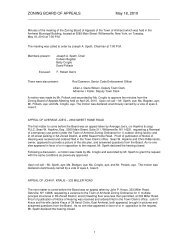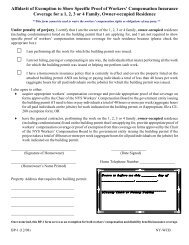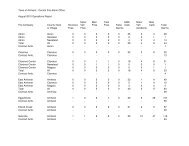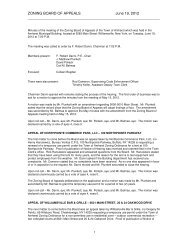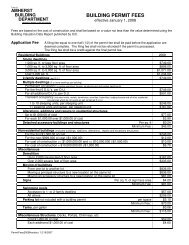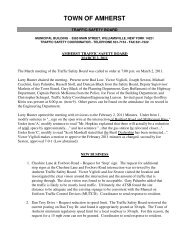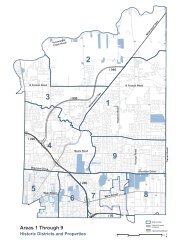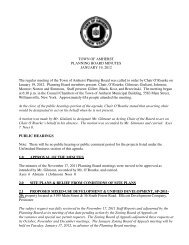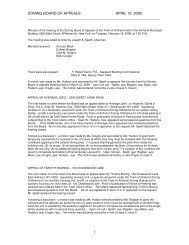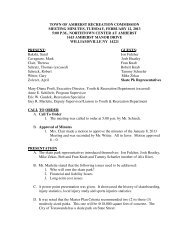3.0 Land Use and Development - Town of Amherst
3.0 Land Use and Development - Town of Amherst
3.0 Land Use and Development - Town of Amherst
Create successful ePaper yourself
Turn your PDF publications into a flip-book with our unique Google optimized e-Paper software.
TOWN OF AMHERST BICENTENNIAL COMPREHENSIVE PLAN<br />
The <strong>Town</strong> <strong>of</strong> <strong>Amherst</strong> also has been able to <strong>of</strong>fer exemptions<br />
that are limited both by their scope <strong>and</strong> their geography under<br />
Section 485-b <strong>of</strong> the New York State Code. Section 485-b<br />
exemptions only apply to the <strong>Town</strong>’s share <strong>of</strong> property taxes,<br />
which is a small percentage <strong>of</strong> what property owners pay.<br />
These benefits are only available in certain redevelopment<br />
areas within the <strong>Town</strong>, including older commercial districts<br />
like Eggertsville <strong>and</strong> Snyder, as well as highway-oriented strips<br />
like older sections <strong>of</strong> Sheridan Drive <strong>and</strong> Transit Road.<br />
Recent policy changes by the <strong>Amherst</strong> <strong>Town</strong> Board (see<br />
below) may help, as they authorize the IDA to assist by<br />
<strong>of</strong>fering abatements for sales taxes on construction materials<br />
<strong>and</strong> mortgage recording taxes to properties located in 485-b<br />
zones.<br />
In the past, the bulk <strong>of</strong> these abatements have only been<br />
available for new construction; abatements for rehabilitation<br />
only applied to the value added by renovation, excluding the<br />
existing property assessment amount. However, recent<br />
changes in policy have broadened the scope <strong>of</strong> IDA<br />
abatements. The <strong>Amherst</strong> IDA has recently joined with the<br />
Erie County IDA <strong>and</strong> the other four local IDA’s in the<br />
county to develop a st<strong>and</strong>ard, county-wide eligibility policy for<br />
tax abatements.<br />
In addition to the “greenfield” industrial <strong>and</strong> commercial<br />
development, the new eligibility policy has broadened the<br />
horizons <strong>of</strong> the tax abatements to include:<br />
• Multi-tenant commercial buildings: Multi-tenant<br />
<strong>of</strong>fice or industrial buildings are now included in the<br />
abatement program, provided that at least two-thirds <strong>of</strong> a<br />
given building’s tenants are in one <strong>of</strong> the IDA’s priority<br />
industry designations (manufacturing, distribution,<br />
business services, <strong>and</strong> arts/entertainment/recreation).<br />
This policy may allow for more multi-tenant, urbanoriented<br />
<strong>of</strong>fice developments, as such locations are likely<br />
to be more desirable for multi-user rather than single-user<br />
buildings.<br />
• Long-term care/assisted living: Residential projects<br />
<strong>of</strong>fering continuing medical care to senior citizens in need<br />
<strong>of</strong> such living arrangements are now eligible for<br />
abatements. Since it was determined for the Inventory <strong>and</strong><br />
Analysis Report that the economics <strong>of</strong> assisted living<br />
facilities in <strong>Amherst</strong> are difficult, sales tax <strong>and</strong> property<br />
tax abatement (10-year) for such projects can help make<br />
them viable for private operators.<br />
• Civic facilities: Three categories <strong>of</strong> civic facilities in<br />
particular are specified in the IDA eligibility criteria –<br />
3-12<br />
<strong>Town</strong> Board Adopted Plan (Amended March 2009) – <strong>L<strong>and</strong></strong> <strong>Use</strong> <strong>and</strong> <strong>Development</strong>





